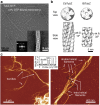TubZ filament assembly dynamics requires the flexible C-terminal tail
- PMID: 28230082
- PMCID: PMC5322520
- DOI: 10.1038/srep43342
TubZ filament assembly dynamics requires the flexible C-terminal tail
Abstract
Cytomotive filaments are essential for the spatial organization in cells, showing a dynamic behavior based on nucleotide hydrolysis. TubZ is a tubulin-like protein that functions in extrachromosomal DNA movement within bacteria. TubZ filaments grow in a helical fashion following treadmilling or dynamic instability, although the underlying mechanism is unclear. We have unraveled the molecular basis for filament assembly and dynamics combining electron and atomic force microscopy and biochemical analyses. Our findings suggest that GTP caps retain the filament helical structure and hydrolysis triggers filament stiffening upon disassembly. We show that the TubZ C-terminal tail is an unstructured domain that fulfills multiple functions contributing to the filament helical arrangement, the polymer remodeling into tubulin-like rings and the full disassembly process. This C-terminal tail displays the binding site for partner proteins and we report how it modulates the interaction of the regulator protein TubY.
Conflict of interest statement
The authors declare no competing financial interests.
Figures





Similar articles
-
Filament formation of the FtsZ/tubulin-like protein TubZ from the Bacillus cereus pXO1 plasmid.J Biol Chem. 2012 Sep 14;287(38):32103-12. doi: 10.1074/jbc.M112.373803. Epub 2012 Jul 30. J Biol Chem. 2012. PMID: 22847006 Free PMC article.
-
In vitro assembly studies of FtsZ/tubulin-like proteins (TubZ) from Bacillus plasmids: evidence for a capping mechanism.J Biol Chem. 2008 Mar 28;283(13):8102-9. doi: 10.1074/jbc.M709163200. Epub 2008 Jan 15. J Biol Chem. 2008. PMID: 18198178 Free PMC article.
-
Reconstitution of a prokaryotic minus end-tracking system using TubRC centromeric complexes and tubulin-like protein TubZ filaments.Proc Natl Acad Sci U S A. 2015 Apr 14;112(15):E1845-50. doi: 10.1073/pnas.1423746112. Epub 2015 Mar 30. Proc Natl Acad Sci U S A. 2015. PMID: 25825718 Free PMC article.
-
Tubulin-Like Proteins in Prokaryotic DNA Positioning.Subcell Biochem. 2017;84:323-356. doi: 10.1007/978-3-319-53047-5_11. Subcell Biochem. 2017. PMID: 28500531 Review.
-
Evolution of cytomotive filaments: the cytoskeleton from prokaryotes to eukaryotes.Int J Biochem Cell Biol. 2009 Feb;41(2):323-9. doi: 10.1016/j.biocel.2008.08.010. Epub 2008 Aug 13. Int J Biochem Cell Biol. 2009. PMID: 18768164 Review.
Cited by
-
Plasmid Localization and Partition in Enterobacteriaceae.EcoSal Plus. 2019 Jun;8(2):10.1128/ecosalplus.ESP-0003-2019. doi: 10.1128/ecosalplus.ESP-0003-2019. EcoSal Plus. 2019. PMID: 31187729 Free PMC article. Review.
References
Publication types
MeSH terms
Substances
LinkOut - more resources
Full Text Sources
Other Literature Sources
Miscellaneous

